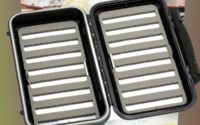| Disclosure: Just to be open and honest the buttons and links you click on in the website will in most cases take you to another website where you can purchase the products I am reviewing. As an Amazon Associate I earn from qualifying purchases. |
Why Is My Fly Fishing Line Cracking: Maintenance Check
Quick Post Navigation
Introduction
Fly fishing enthusiasts often encounter the frustrating issue of fly line cracking. This problem not only affects the casting performance but also poses a risk of damage to the fishing equipment and affects the overall fishing experience. Understanding why fly lines crack and how to prevent it is essential for every angler.
Understanding Fly Lines
Fly lines are an integral part of fly fishing gear, designed to facilitate casting and presentation of flies to fish. They consist of a core material, often made of braided nylon or monofilament, coated with a layer of PVC or similar material. This coating is what provides the weight and buoyancy necessary for casting and controlling the fly. Additionally, various additives such as plasticizers, UV inhibitors, and lubricants are incorporated into the coating to enhance durability and performance.
Common Causes of Fly Line Cracking
While fly lines are engineered to withstand the rigors of fishing, several factors can contribute to their deterioration and eventual cracking:
- UV Exposure: Prolonged exposure to sunlight is one of the primary culprits behind fly line cracking. UV rays can break down the molecular structure of the PVC coating, causing it to become brittle and prone to cracking. This is especially true for fly anglers who fish in sunny climates or spend long hours on the water.
- Improper Storage: Storing fly lines in unfavorable conditions can also accelerate their deterioration. Excessive heat, humidity, and exposure to chemicals or sharp objects can degrade the PVC coating, leading to premature cracking. Anglers should store their fly lines in a cool, dry place away from direct sunlight and extreme temperatures.
- Age and Wear: Like any fishing equipment, fly lines experience wear and tear over time. The repeated stress of casting, retrieving, and fighting fish can gradually degrade the PVC coating, making it more susceptible to cracking. Additionally, knots and abrasions caused by contact with rocks, vegetation, or other obstacles can weaken the fly line and compromise its integrity.
- Low-Quality Materials: Not all fly lines are created equal, and inferior quality materials are more prone to cracking and other forms of damage. Cheaply manufactured fly lines may lack the necessary additives and quality control measures to withstand the demands of fly fishing. Investing in a high-quality fly line from a reputable manufacturer is crucial for ensuring durability and longevity.
Effects of Fly Line Cracking
The consequences of cracked fly lines extend beyond mere inconvenience:
- Decreased Casting Performance: Cracks and imperfections in the fly line’s surface disrupt its aerodynamics, resulting in decreased casting distance and accuracy. Anglers may notice a loss of control and feel while casting, as well as reduced line floatation and mending capabilities.
- Potential Damage to Rod Guides: Sharp edges on cracked fly lines can damage rod guides, affecting the overall functionality of the fishing rod. This can lead to decreased casting distance, line friction, and potentially lost fish due to line breakage or tangles.
- Impact on Fish Presentation: Fly fishing relies on the precise presentation of artificial flies to entice fish. Cracked fly lines may cause irregularities in the movement of the fly, affecting its drift, speed, and overall realism. This can result in wary fish rejecting the fly or spooking at the sight of an unnatural presentation.
Preventive Measures
To prolong the lifespan of fly lines and prevent cracking, anglers can take several precautions:
- Proper Storage Techniques: Store fly lines in a cool, dry place away from direct sunlight and extreme temperatures. Avoid storing them in hot car trunks or exposed to harsh chemicals or sharp objects.
- UV Protection Methods: Use fly line cleaners and conditioners with UV inhibitors to protect against sun damage. Apply these products regularly to maintain the integrity and flexibility of the PVC coating.
- Regular Maintenance and Inspection: Clean and inspect fly lines regularly for signs of wear or damage, and replace them as needed. Check for cracks, abrasions, knots, and other imperfections that may compromise performance or durability.
Repairing Cracked Fly Lines
In some cases, cracked fly lines can be repaired to extend their lifespan:
- DIY Methods: Simple repairs such as applying a thin layer of super glue to small cracks or using fly line patches can temporarily fix minor damage. However, these solutions may not be suitable for large or structural cracks and may affect casting performance.
- Professional Repair Services: For more extensive damage, professional repair services specializing in fly fishing equipment can provide expert solutions. These may include heat welding, splice repairs, or complete fly line replacement, depending on the severity of the damage.
Importance of Quality Fly Lines
Investing in high-quality fly lines is crucial for avid anglers:
- Longevity and Performance Benefits: Quality fly lines are more durable and resistant to cracking, ensuring consistent casting performance and fish presentation. They maintain their buoyancy, flexibility, and coating integrity over time, providing reliable performance season after season.
- Investment in Durable Fly Lines: While quality fly lines may come at a higher initial cost, their longevity and performance benefits justify the investment for serious anglers. A durable fly line can withstand years of use and abuse, ultimately saving money in the long run by reducing the need for frequent replacements and repairs.
Conclusion
Understanding the causes of fly line cracking and implementing preventive measures are essential for preserving the integrity and performance of fly fishing gear. By investing in quality fly lines and adopting proper maintenance practices, anglers can enjoy a more fulfilling and successful fishing experience.
FAQs:
Can I repair a cracked fly line myself?
- Yes, minor cracks can be temporarily repaired using DIY methods such as super glue or fly line patches. However, for more extensive damage, professional repair services may be necessary.
How often should I inspect my fly line for damage?
- It’s advisable to inspect your fly line before each fishing trip and perform a more thorough inspection periodically, especially after prolonged use or exposure to harsh conditions.
Are there any products specifically designed to protect fly lines from UV damage?
- Yes, there are various fly line cleaners and conditioners available on the market that contain UV inhibitors to protect against sun damage. Regular application of these products can help extend the lifespan of your fly line.
What is the average lifespan of a fly line?
- The lifespan of a fly line can vary depending on factors such as usage, storage conditions, and quality. With proper care and maintenance, a quality fly line can last several seasons or even longer.
Can cracked fly lines affect my fishing success?
- Yes, cracked fly lines can impair casting performance and fish presentation, potentially affecting the success of your fishing endeavors. It’s essential to address any damage to your fly line promptly to ensure optimal performance on the water.



